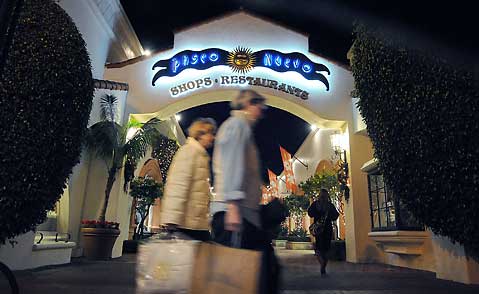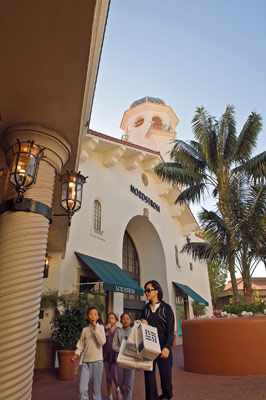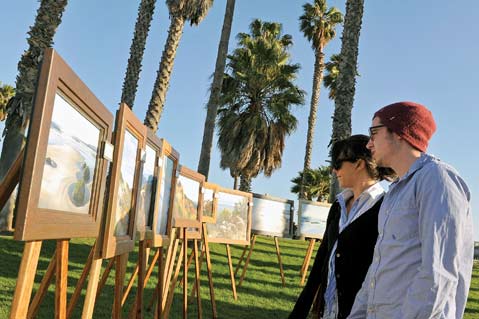Tracking Tomorrow’s Travelers
S.B. Conference and Visitors Bureau Hosts Tourism Forecasting Discussion

More than 150 tourism-curious individuals – from hotel managers and museum directors to event promoters, food and wine representatives, and politicians – gathered at the Fess Parker Doubletree on Tuesday morning to listen to experts discuss the state of the travel industry. The news that the recession seems to be over and that the tourists will be slowly returning was generally optimistic, but no one was caught donning a pair of rose-colored glasses.
As CVB president Kathy Janega-Dykes explained in her opening remarks, a slower tourism trade will be the status quo for some time, so everyone would do well to get used to the “new normal.” Janega-Dykes did say, however, that the industry could look to the affluent sector as it seeks to emerge out of the economic doldrums, as research shows that “they don’t want to spend money on stuff, but invest in experiences instead.”
The morning’s first invited speaker was Dan Mishell, the research director of the California Travel & Tourism Commission. Focused on getting travelers to come into California from outside the state, Mishell’s commission is behind the new California marketing campaign, featuring television commercials and magazine advertisements with the likes of Rob Lowe, Arnold Schwarzenegger, and other Golden State faces.

Mishell gave a rundown on California tourism, explaining that 49 percent of the $97 billion annual tourism dollars are spent by in-state travelers, 32 percent comes from other Americans, and 19 percent is from international tourists. Of the other Americans, the bulk comes from Western states as well as the more populous states of Illinois, Texas, and New York. Internationally, 78 percent of California’s visitors come from just seven countries – Mexico accounts for 50 percent of that, then comes Canada, the United Kingdom, Germany/Austria/Switzerland (lumped as one country, apparently), Australia, Japan, and South Korea.
In 2009, both domestic and international tourism were down. In March, occupancy rates were down 14 percent, explained Mishell, though they have rebounded to just down four percent in September. However, the revenues are still sagging, because rates remained down 12 percent in September. Overall, Mishell’s charts showed that the state’s domestic tourism levels are down 3 percent in 2009, but should jump by 2 percent in 2010. International tourists are down more, a 10.2 percent drop from a big year in 2008, although Mishell’s research shows a potential for 3.7 percent growth in 2010, with a big eye on China and India as the emerging markets. Into the long run, Mishell said, “We’re expecting a return to 2007 levels by 2011.”
Up next was Bruce Baltin, the vice president of PKF Consulting, which tracks the hospitality and real estate industries. Though he said that this was the worst economic time for hotels since the Great Depression of the 1930s, he explained to the Santa Barbara County crowd, “You’re hurt less than most of the country.” That’s in large part because the beach resort segment is fairing well, and he expects a two percent growth in occupied rooms for 2010. Baltin explained that now is the time to attract new customers with creative marketing, in that those who have taken time off from traveling will be seeking new opportunities. “This is an opportunity to expand your horizons,” he said.

That push for creativity was echoed by Tim Bridwell, who once worked at the Fess Parker Doubletree but is now vice president of new project development for Hilton. He explained that, for Hilton, “Business is down 20 percent, but customer satisfaction is up 6.8 percent. What’s wrong with that model?” He posited that it reflected lower expectations, but also the fact that some hotels are stepping up to enhance customer service. He pointed to The Wit Hotel in Chicago, where guests are treated to the sounds of roosters in the morning and crickets at night. “We have to be different than we’ve been in the past,” pledged Bridwell.
He pushed for continual diligence on website maintenance and other forms of reaching out digitally. “If we’re not paying attention to what we’re doing electronically every day, then we’re missing the bus,” Bridwell said. He also advocated for a greener future. “Sustainability is cool,” he said. “It’s the thing people want, and it saves us money.”
Last to speak before the roundtable conversation with the audience was Rosemark McCormick, executive director of the Shop America Alliance. As an expert on the shopping traveler, McCormick dropped facts and figures on how much shopping can motivate tourists – to the tune of $38.6 billion in California alone. McCormick explained that plenty of foreign tourists have expressed desire to see a “shopping festival” – which is something done in places like Dubai – so her organization is working to get one of those in California by 2011. According to her research, the average “shopping tourist” spends about $3,700 per trip, with Mexican tourists leading the foreign spenders, using up to 40 percent of their budgets in retail shops.
McCormick also presented information on “cultural and heritage travelers,” those 118.3 million tourists who visit historical and cultural destinations each year. McCormick advised Santa Barbara’s hospitality industry to become the cultural star of California. “They spend more, the travel more frequently, and they stay longer,” she explained.
The speeches were followed by half-hour or so of questions and conversation with the audience.



